Items
Subject is exactly
Protest
-
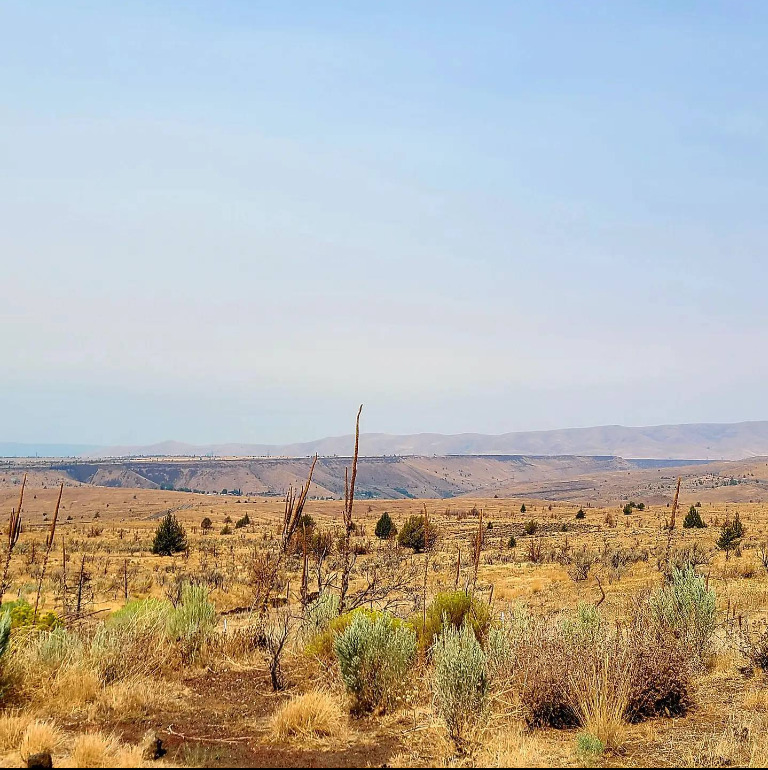 2021-08-15
2021-08-15Pandemics, Wildfires, and Climate Change
The Covid 19 Pandemic is and was a transformative event representing history in the making. The state of Oregon and particularly Portland witnessed a trifecta of converging crises beginning with the lockdown on St. Patrick’s Day in 2020. That summer was one of the hottest in recorded history and saw the city and state divided in smoke-filled chaos. The literal last words of “I can’t breathe” uttered by George Floyd were being chanted in the streets downtown as wildfires raged in all corners of the state, set against the backdrop of a global pandemic. Everything felt surreal and the tension in the city was like a powder keg. By the following summer some advancements had been made, the first round of vaccinations administered, but the same underlying issues were present in Portland. Houselessness, fractured political ideologies, and Far-Right and Far-Left members clashing in an invisible maelstrom on the Willamette River. My husband and I had adhered to the very stringent guidelines and protocol set by both the city and state to the letter. For a bit of context, my husband worked on the front line as a department manager at a grocery store and wore a mask for eleven hours at a time often six days a week for a year and a half, while I volunteered at the Red Cross and held down the home front. In August of 2021, we finally decided that we needed to get out of town, so we grabbed the dog and set a course for the Crooked River in Central Oregon. It was a two-week period of sheer peace and glory bookended by fear and anger at the negligence of fellow humans. We camped on the river and practiced mindfulness and being present every day, breathing deeply the fresh air ushered in by a strong breeze from the East. The “going there” and “going home” portions were marred by anti-mask protestors with weapons arguing about state’s rights, as death toll numbers were rising. The fires had already burned over a million acres with no signs of slowing down, and the reality of Portland’s social justice issues did not disappear just because we did. The experience left us feeling gratitude for the opportunity to explore, our good health, and open minds, it was our 18th wedding anniversary, in which porcelain is traditionally given as a gift. Ironic, given the fact that not only is porcelain extraordinarily beautiful but also incredibly delicate, a perfect representation of the state of things during the summer of 2021. -
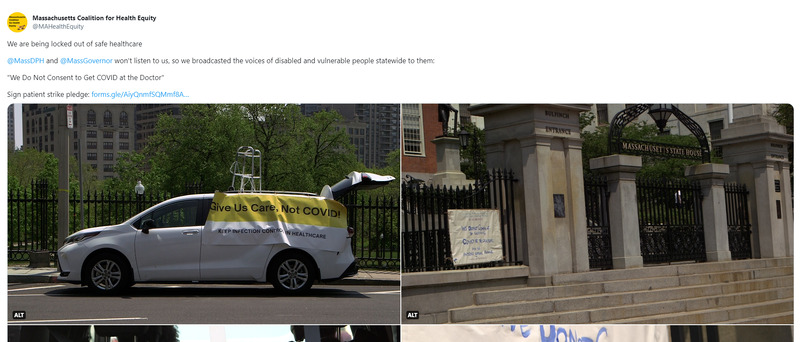 2023-05-14
2023-05-14Pandemics are Not "Great Equalizers" - Comparing COVID-19 to the Bubonic Plague Outbreak of 1870-1905
With the designation of COVID-19 as a "public health emergency" by the Centers for Disease Control and Prevention (CDC) ending as of May 11, 2023, public healthcare facilities throughout the US are rolling back protections they once employed to try to keep people safer during this ongoing pandemic. So, as this unit asks of us students, are pandemics the “great equalizers” in terms of social inequalities, and is there more equality now that the "emergency" has been deemed to be over? I argue that this is not the case, as immune compromised and disabled people have been more or less left for dead. A huge swath of healthcare facilities have removed mask mandates for care providers and hospital visitors, which leaves vulnerable and immune compromised people at a much higher risk of getting COVID-19 while receiving the medical care that is necessary for them to manage their conditions. In response, people and organizations, such as the Massachusetts Coalition for Health Equity in the tweet above, have begun to mobilize in favor of maintaining COVID-19 protections in healthcare settings by organizing strikes, protests, petitions, and phone banks to public officials. The reasons for maintaining COVID precuations such as mask mandates, access to COVID tests, and enhanced filtration in healthcare settings are clear. As the Massachusetts Coalition for Health Equity describes in their petition titled "Patient Strike Authorization Vote," the CDC "advises immunocompromised people to avoid crowded indoor settings, which now includes all healthcare institutions without universal masking," essentially maintaining that COVID is dangerous to immune compromised people while giving them no option but to risk exposure if they want to receive their necessary healthcare (Patient Strike Authorization Vote). The petition text explains that "[n]ational leaders in hospital epidemiology argue that universal masking should become the new standard of care, as gloves became with HIV" in order to keep people with compromised immune systems such as young children and elders safe (Patient Strike Authorization Vote). Currently, disabled and immune compromised people "are being locked out of safe healthcare" and are facing discrimination that makes them unwelcome and unsafe in healthcare settings (Massachusetts Coalition for Health Equity). In order to relate this modern COVID-19 pandemic to our course materials and demonstrate that discriminatory treatment during times of disease is not new, I will compare the above post to points from the text "The Chinese as Medical Scapegoats In San Francisco, 1870-1905" by Joan B. Trauner. This text discusses the discrimination against Chinese and other East Asian people living in San Francisco's Chinatown during a bubonic plague outbreak in the late nineteenth century. Sinophobic and anti-Asian sentiments, similar to those that arose during the epidemic Trauner details, have also been evident throughout the COVID-19 pandemic, so much so that even US President Donald Trump referred to COVID-19 as the "China virus." Ableism has also been prevalent throughout the COVID pandemic, as many people no longer care about the effects of the virus, because it harms disabled and immune compromised people most, especially people who also face racial discrimination in healthcare. Trauner explains that, because white people in the US believed the plague primarily affected Chinese and other Asian people, and because plagues were bad for business,"[t]he governor of California, Henry T. Gage, and executives of big business and of the large railroads, in conjunction with the San Francisco Board of Trade, the San Francisco Chamber of Commerce, and the Merchants Association, were all determined to prove that the plague did not exist in San Francisco" (78). The author of the Patient Strike Authorization Vote argues that today, we see a similar pro-business sentiment that comes at the expense of immune compromised people who are more likely to get sick with and die from COVID-19, writing: "Hospitals that remove masks and surveillance testing are making a value judgement about our lives, because they want to preserve their profit margins" (Patient Strike Authorization Vote). The CDC's ending of the COVID-19 public health emergency designation and the resulting halt of COVID mitigation procedures indicate that people are ignoring the needs of immune compromised people so that everyone can feel more comfortable going "back to normal" and maintaining consumption habits that are desired by businesses. Additionally, in both the past plague outbreak and the current pandemic, public health officials have shown hesitancy to give people vital information, which has led to harm. As Trauner explains, during the bubonic plague epidemic, "San Francisco Mayor Eugene Schmitz refused to approve the printing of health reports and vital statistics and even attempted to remove from office four members of the Board of Health who persisted in stating that plague existed in San Francisco" (79). Today, because the public health emergency designation ended on May 11th, 2023, the CDC is "no longer reporting aggregate cases and deaths, COVID-19 Community Levels, COVID-19 Community Transmission Levels, or COVID-19 Electronic Laboratory Reporting (CELR) data," all of which have been used to determine the severity of the situation throughout the pandemic (COVID Data Tracker). Meanwhile, over one thousand people are dying of COVID every single week, but COVID transmission levels are not being tracked, so people cannot know how many COVID positive cases there are in their county and how likely they are to contract the virus by going out in public (COVID Data Tracker). Another similarity between the COVID-19 pandemic and the bubonic plague outbreak of the late nineteenth century lies in the responses of the people facing discriminatory treatment in public health settings during these respective disease outbreaks. Trauner writes that before, during, and after the bubonic plague outbreak, Chinese businesses and health practitioners constructed and operated their own hospitals that would treat the people of Chinatown, because they were not welcome at other hospitals due to racial discrimination (81). Trauner explains that "[e]arly Chinese immigrants realized the necessity of banding together and providing for their own health care needs," in light of the government abandoning their health needs (81). Activists and organizations like the Massachusetts Coalition for Health Equity are currently banding together and fighting to get better and safer care for immune compromised people during the COVID-19 outbreak, as they are also facing discrimination at hospitals rolling back COVID precautions, because these spaces are not safe for them. The organizing they are doing to try to make healthcare settings safer for immune compromised people looks different, as no one is proposing the creation of immunocompromised-specific hospitals. They are fighting for better treatment, still, using slogans like "We Do Not Consent to Get COVID at the Doctor," and urging people that "[w]e must take collective action to prevent this mass violation of our human rights and federal rights to safe care," as stipulated under the Americans with Disabilities Act (Massachusetts Coalition for Health Equity). In both disease outbreaks, it has been the duty of those being discriminated against to take care of and advocate for themselves. So, in fact, pandemics are not "great equalizers"; in reality, they not only make pre-existing inequities even more visible, but exacerbate them even further. As Trauner argues, "Health policy [...] manifests not only the state of the medical sciences, but the expectations and the value system of society-at-large," and as such, if society-at-large is racist and ableist, then the health policies put into place will reflect these discriminatory values (70). These governmental measures come at a cost to everyone, and especially those facing racist and ableist discrimination. Had the nineteenth-century bubonic plague outbreak been determined an emergency and treated as a serious threat in spite of sinophobic and anti-Asian sentiments, perhaps more research could have been carried out sooner, and more lives could have been saved. If people in the US continue to take the COVID-19 pandemic seriously and not dismiss the pleas of immune compromised and disabled people to continue precautions, perhaps loss of life and further disablement from COVID infection can be mitigated. -
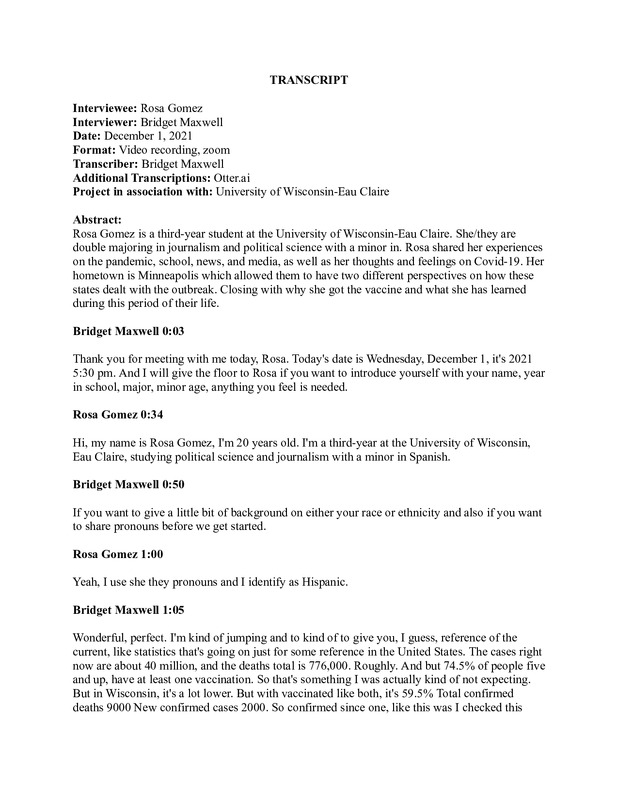 12/01/2021
12/01/2021Rosa Gomez Oral History, 2021/12/01
Rosa Gomez is a third-year student at the University of Wisconsin-Eau Claire. She/they are double majoring in journalism and political science with a minor in. Rosa shared her experiences on the pandemic, school, news, and media, as well as her thoughts and feelings on Covid-19. Her hometown is Minneapolis which allowed them to have two different perspectives on how these states dealt with the outbreak. Closing with why she got the vaccine and what she has learned during this period of their life. -
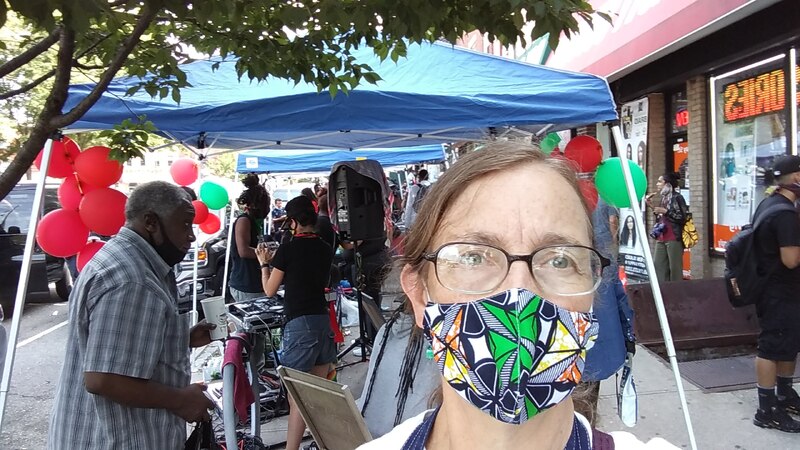 2020-06-22
2020-06-22Outside on the streets of Staten Island and Brooklyn
These photos depict some of the events and activities I was part of during the summer of 2020. I marched to protest the killings of innocent black men by police, I attended a street festival held in honor of Eric Garner (on the anniversary of his death), I worked at a Brooklyn Greenmarket doing "covid support" (a very stressful job), and I visited the peaceful grounds of Snug Harbor, wearing my favorite polka-dot mask made by a friend. -
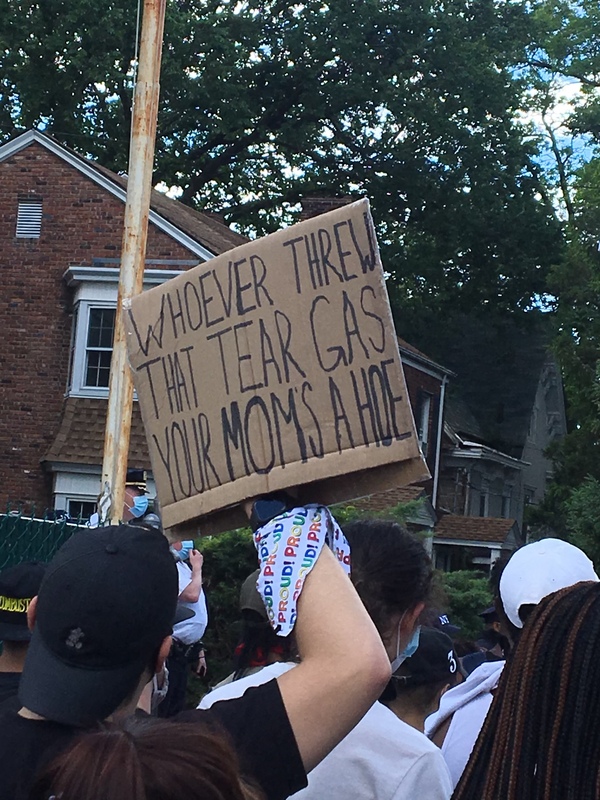 2020-06-09
2020-06-09George Floyd protest
“This is from a protest on June 9th, 2020 I went to, which was in protest of the police and George Floyd’s death. The sign spoke to me and it’s the only picture I have from that day. But I feel like I was part of history that day. It was the first thing I went to with my friends or people since the lockdown started. Before that, I was alone with my family and my thoughts. And so it marked the beginning of a new world of change that we embarked upon.” -
 2020-06-05
2020-06-05Staten Island during the Covid-19 Pandemic
Photos depicting Staten Island Protest during Covid-19 -
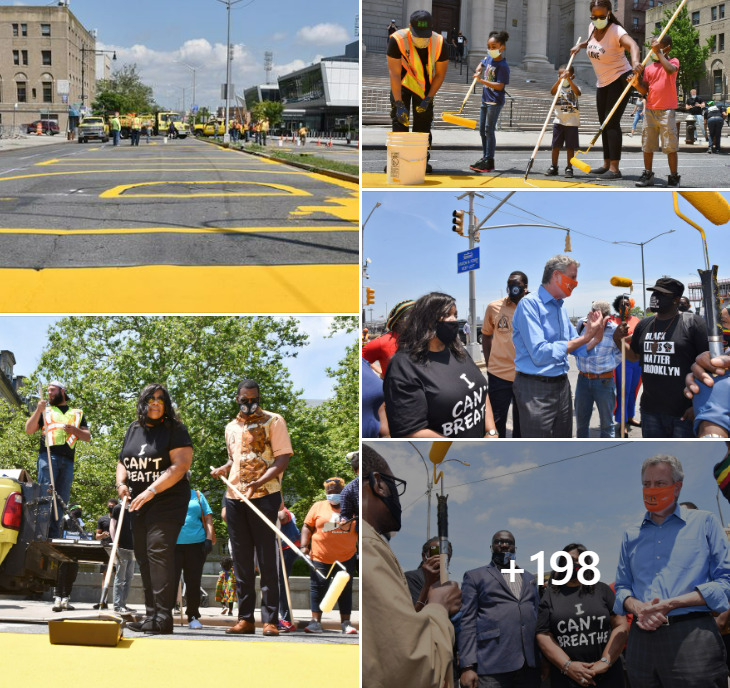 September 2, 2020
September 2, 2020BLM
BLM -
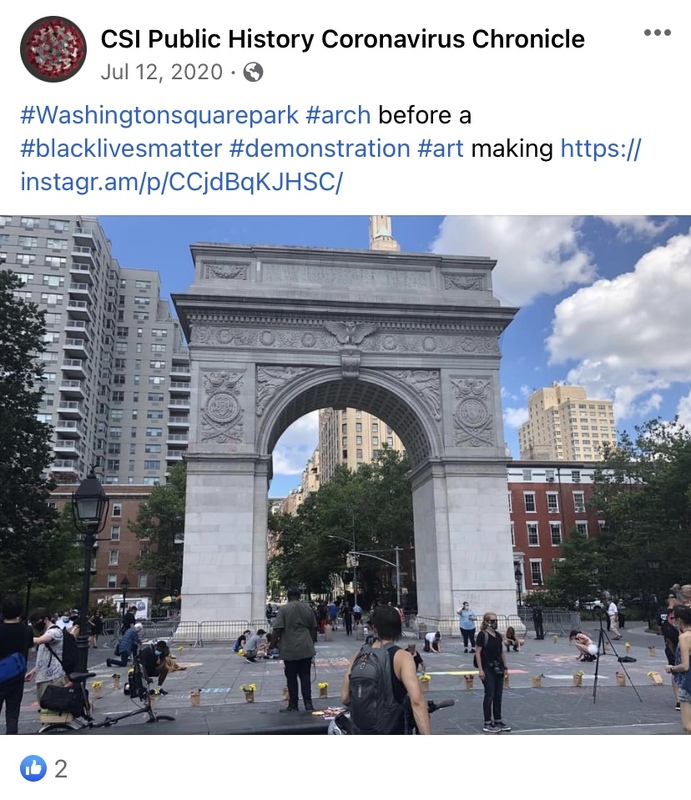 July 12, 2020
July 12, 2020Arch of Washington Square park during BLM demonstration
Screenshot of washington Square park arch before a BLM demonstration from the CSI Public History Coronavirus Chronicle Facebook page -
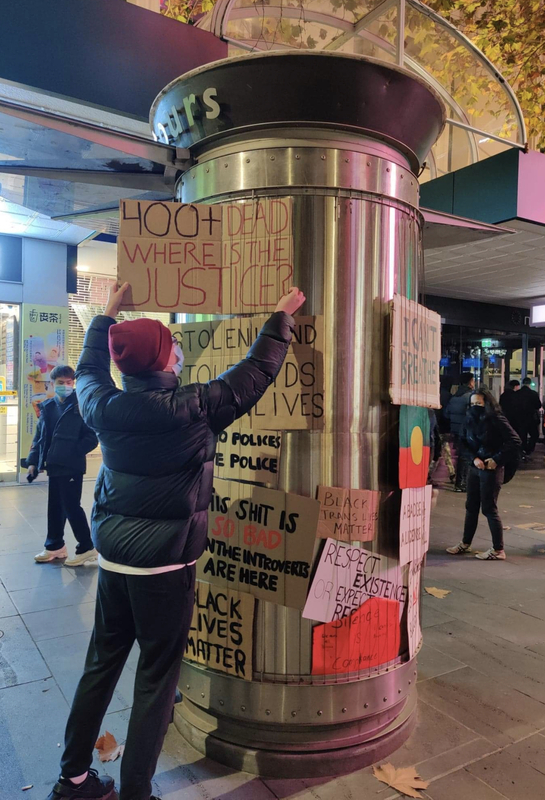 2020-06-06
2020-06-06History within History
HIST30060: This photo was taken at the Melbourne Black Lives Matter protest in June of 2020, it was one amongst the wave of protests taking place across the world sparked by protests in the United States following George Floyd's death at the hands of the police. It was the second protest I had attended and the sheer number of people attending to show solidarity with people of colour in the US and shed light on police issues at home was an inspiring sight despite the harrowing reality of it all. Figures such as the Prime Minister at the time cited health risks as reason to not demonstrate, but this potential of COVID spreading however was consistently weaponised by conservative pundits (despite their consistent calls for lax restrictions). to discredit the movement. -
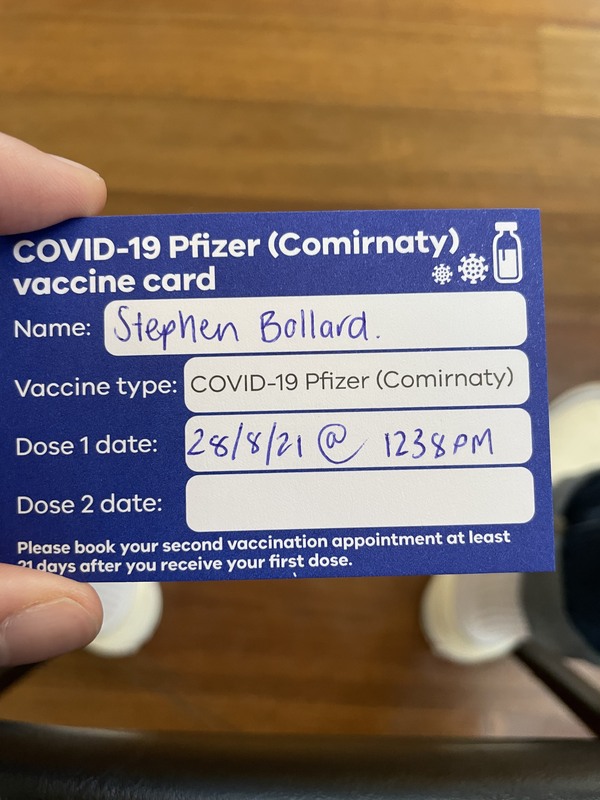 2021-08-28
2021-08-28The First Jab
HIST30060: This is an image of when I was waiting to leave the Royal Exhibition Building following my first vaccination. The experience was not something I was unfamiliar with, throughout high school I received regular vaccinations, the only downside this time was there not being a bowl of lollies to reward myself with as there was during high school. I had been anticipating the worst of symptoms after what I had heard from others, but fortunately all I really got was a stiff arm. This was also amidst the beginnings of the anti-vax movement and protests that we unfortunately are so accustomed to at this point. -
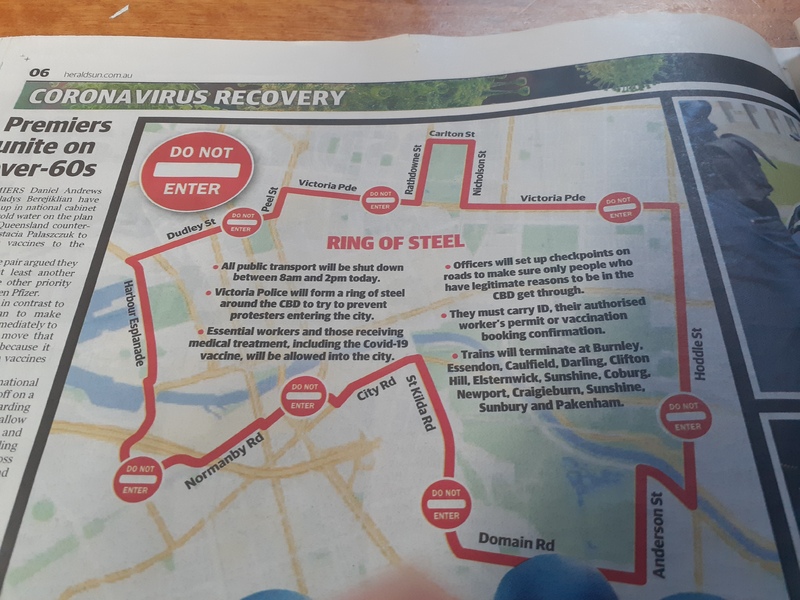 2021-09-18
2021-09-18The ring of Steel
This photo shows a newspaper article published during Melbourne's 2021 lockdown. Following significant anti-lockdown protests in the CBD, the police enacted a 'ring of steel' around the CBD to prevent further protests. I was actually turned around at one of the checkpoints (unaware that the city had been shut) earlier that morning on my morning run. This was one of the most dystopian moments from the whole pandemic and highlighted the lengths the government was willing to take to stop the protests in Melbourne. -
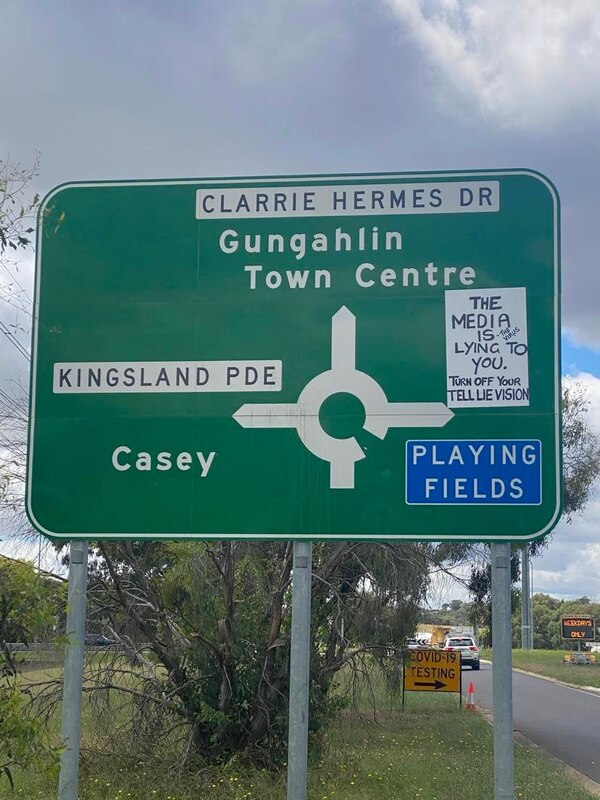 2022-02-04
2022-02-04HIST30060: Canberra Test Centre
This photograph depicts negative popular responses towards public messaging about the pandemic. On the Canberran road sign, a sticker reads, “The media is (the virus) lying to you. Turn off your tell lie vision.” At the bottom of the corner, a sign points towards a PCR test centre. This photograph was taken in February 2022. It is likely that this sticker was posted by a Freedom Rally protester. In January 2022, the Freedom Rally attracted thousands of protesters to Canberra in protest of the government’s response to the pandemic. The “Canberra Convoy” drove from all parts of the country to protest in front of parliament house. While the protesters’ concerns primarily revolved around the vaccination mandate and media censorship, the movement evolved to include all manner of political concerns, including housing affordability, the rising mental health crisis, religious freedoms et cetera. This photograph illustrates how the government measures and media coverage of the pandemic were not universally accepted but rather hotly contested in some places. The Freedom Rally, for example, attracted over 100,000 people to the nation’s capital. The photograph further shows popular anger towards the media coverage of the pandemic. The Australian Broadcasting Channel in particular attracted the ire of the anti-vaccination and anti-mandate movement for contributing towards increased fear of the virus and support for the vaccine. -
 2022-06-25
2022-06-25Respecting bodily autonomy
This is a tweet from metraux_julia. She is discussing the importance of wearing a mask for those that could be at high risk. For disabled people, they often face higher chances of getting COVID, in addition to having more complications with it. This is an advisement specifically for attending protests. -
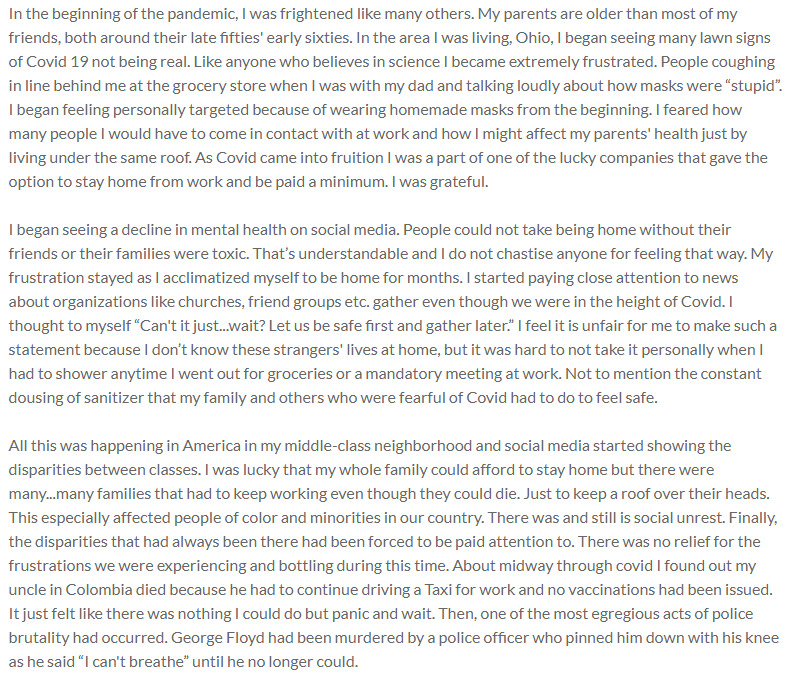 2020-06-01
2020-06-01A privilaged white latina women.
In the beginning of the pandemic, I was frightened like many others. My parents are older than most of my friends, both around their late fifties' early sixties. In the area I was living, Ohio, I began seeing many lawn signs of Covid 19 not being real. Like anyone who believes in science I became extremely frustrated. People coughing in line behind me at the grocery store when I was with my dad and talking loudly about how masks were “stupid”. I began feeling personally targeted because of wearing homemade masks from the beginning. I feared how many people I would have to come in contact with at work and how I might affect my parents' health just by living under the same roof. As Covid came into fruition I was a part of one of the lucky companies that gave the option to stay home from work and be paid a minimum. I was grateful. I began seeing a decline in mental health on social media. People could not take being home without their friends or their families were toxic. That’s understandable and I do not chastise anyone for feeling that way. My frustration stayed as I acclimatized myself to be home for months. I started paying close attention to news about organizations like churches, friend groups etc. gather even though we were in the height of Covid. I thought to myself “Can't it just...wait? Let us be safe first and gather later.” I feel it is unfair for me to make such a statement because I don’t know these strangers' lives at home, but it was hard to not take it personally when I had to shower anytime I went out for groceries or a mandatory meeting at work. Not to mention the constant dousing of sanitizer that my family and others who were fearful of Covid had to do to feel safe. All this was happening in America in my middle-class neighborhood and social media started showing the disparities between classes. I was lucky that my whole family could afford to stay home but there were many...many families that had to keep working even though they could die. Just to keep a roof over their heads. This especially affected people of color and minorities in our country. There was and still is social unrest. Finally, the disparities that had always been there had been forced to be paid attention to. There was no relief for the frustrations we were experiencing and bottling during this time. About midway through covid I found out my uncle in Colombia died because he had to continue driving a Taxi for work and no vaccinations had been issued. It just felt like there was nothing I could do but panic and wait. Then, one of the most egregious acts of police brutality had occurred. George Floyd had been murdered by a police officer who pinned him down with his knee as he said “I can't breathe” until he no longer could. America turned upside down. We saw videos of buildings being destroyed, fires, mass protests, shootings, the worst you could imagen. As a collective we had reached our boiling point and the last straw was this murder. My family was against my brother and I protesting because Covid still being at its height. I have protested at the Womens March in D.C and several pro-choice marches in Ohio but the Black Lives Matter movement was something I needed to educate myself on and stand up for. It was a calling for someone in my position of privilege to show up in numbers for people of color that deserve rights just as the rest of us. I often reflect on how my life could have been so different. My father is Colombian, and my mother is Polish. I look white and have always been raised in a middle-class neighborhood. I have not had to face the same injustices as my father, my family and minority groups in America just based off the color of my skin. Police brutality has always been in existence but when we were all home during Covid with modern day technology and video evidence, we felt that video to the core. We felt the pure rage and frustrations as a society of how we were not being cared for in the way we thought we would have been during this pandemic. I have never witnessed in my lifetime such united support for one another. Such a strong fight against people in power who are coming after the people we call friends, workers, lovers, and family no matter the color of their skin. In such destruction, pain and chaos I had never felt such beauty in our society. I will never forget the feeling of unity around me I had felt as hundreds of people laid down on the hard pavement during the Black lives Matter protest yelling “I cant breathe.” Finally, we could help the unheard be heard and take a deep breath together. -
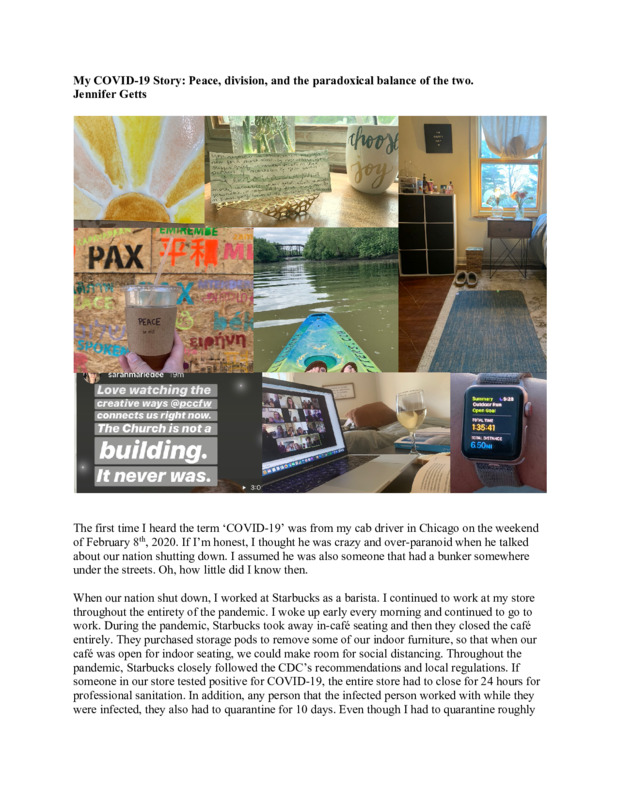 2022-04-29
2022-04-29My COVID-19 Story: Peace, division, and the paradoxical balance of the two.
The COVID-19 pandemic is largely associated with grief, pain, brokenness, division, and death. While that is true, it can also be associated with peace, quietness, solitude, growth, love, and birth. In my story, I try to strike the balance and prove that it is a paradoxical balance that can be weighed evenly. -
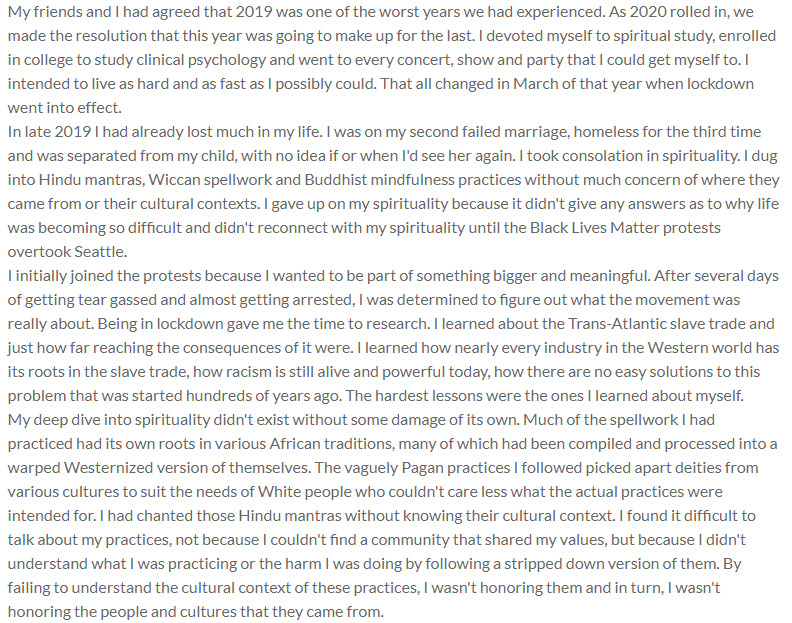 2020-05-29
2020-05-29The Unseen Harm of Western Spirituality
My friends and I had agreed that 2019 was one of the worst years we had experienced. As 2020 rolled in, we made the resolution that this year was going to make up for the last. I devoted myself to spiritual study, enrolled in college to study clinical psychology and went to every concert, show and party that I could get myself to. I intended to live as hard and as fast as I possibly could. That all changed in March of that year when lockdown went into effect. In late 2019 I had already lost much in my life. I was on my second failed marriage, homeless for the third time and was separated from my child, with no idea if or when I'd see her again. I took consolation in spirituality. I dug into Hindu mantras, Wiccan spellwork and Buddhist mindfulness practices without much concern of where they came from or their cultural contexts. I gave up on my spirituality because it didn't give any answers as to why life was becoming so difficult and didn't reconnect with my spirituality until the Black Lives Matter protests overtook Seattle. I initially joined the protests because I wanted to be part of something bigger and meaningful. After several days of getting tear gassed and almost getting arrested, I was determined to figure out what the movement was really about. Being in lockdown gave me the time to research. I learned about the Trans-Atlantic slave trade and just how far reaching the consequences of it were. I learned how nearly every industry in the Western world has its roots in the slave trade, how racism is still alive and powerful today, how there are no easy solutions to this problem that was started hundreds of years ago. The hardest lessons were the ones I learned about myself. My deep dive into spirituality didn't exist without some damage of its own. Much of the spellwork I had practiced had its own roots in various African traditions, many of which had been compiled and processed into a warped Westernized version of themselves. The vaguely Pagan practices I followed picked apart deities from various cultures to suit the needs of White people who couldn't care less what the actual practices were intended for. I had chanted those Hindu mantras without knowing their cultural context. I found it difficult to talk about my practices, not because I couldn't find a community that shared my values, but because I didn't understand what I was practicing or the harm I was doing by following a stripped down version of them. By failing to understand the cultural context of these practices, I wasn't honoring them and in turn, I wasn't honoring the people and cultures that they came from. The Trans-Atlantic slave trade took more than just people from their homelands. It took and often destroyed entire cultures. That which didn't disappear became watered down to suit white tastes as entertainment or a fad. It removed all of the context from many spiritual practices, leaving the cultures they belonged to stripped of autonomy and history. In the modern day, this continues to be a problem. White people continue to consume other cultures for their own gain, often by adopting and reshaping them in a strange attempt at virtue signaling. We are nowhere near finding justice for all of the people that colonialism damaged. A large majority of nations are still considered developing, primarily due to colonialism and capitalism determining that these nations and their people only have value if they can provide something to first world nations. The road to reparation is a long one but it has to start by no longer centering white people and the developed nations and listening to those that have been hurt. -
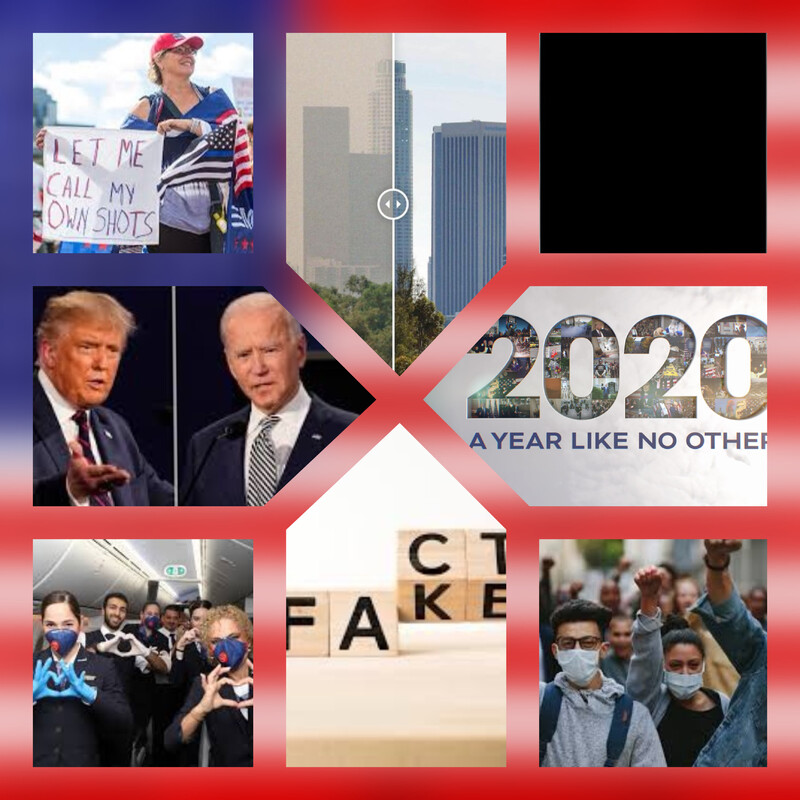 2020-04-06
2020-04-062020 is One for the Books
This collage represents the main events going on in our lives during the Covid-19 pandemic. Like one of my pictures says "2020 A Year Like No Other." I wanted to represent the election of Trump vs. Biden because it will more than likely go down as one of the largest and craziest elections in history. It divided the country like no other and is still an ongoing battle of Republicans vs. Democrats. I wanted to show the black square and the protests for George Floyd along with The Black Lives Matter movement. I added the air pollution of Los Angeles before the pandemic vs during. With everyone staying inside and not driving around, air quality improved tremendously. We gave the Earth a minute to breathe and heal. A quick photo to shoutout the flight attendants who have had to deal with some craziness on board for the last couple years. It has not been easy, and everyone needed a vacation after 2020. The media has been a huge factor and enemy for this pandemic. I wanted to show an illustration towards facts and fake news. A huge debate on that especially with my final photo of the protests on the vaccine mandates. The world is divided more than ever and hopefully one day we can reunite we can reunite and look back on this pandemic and remember to love each other and this planet. There were many lives lost to Covid, to suicide, and addiction. Rest in peace to everyone who didn't make it and my prayers with the families who lost someone. -
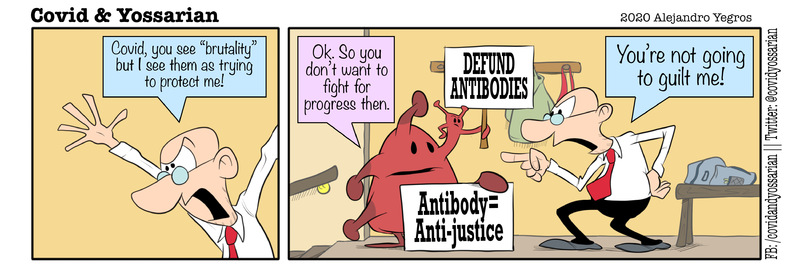 2020-06-11
2020-06-11Defund this
A comic strip about Covid-19 -
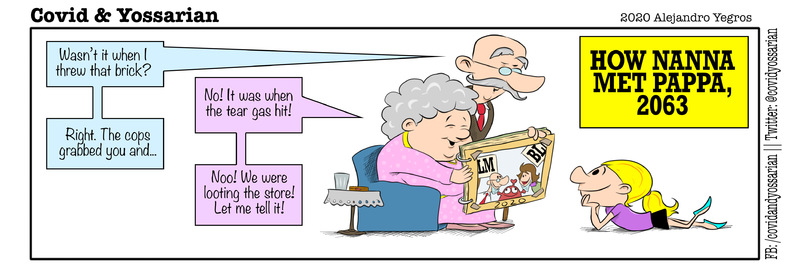 2020-06-10
2020-06-10Protest Love
A comic strip about Covid-19 -
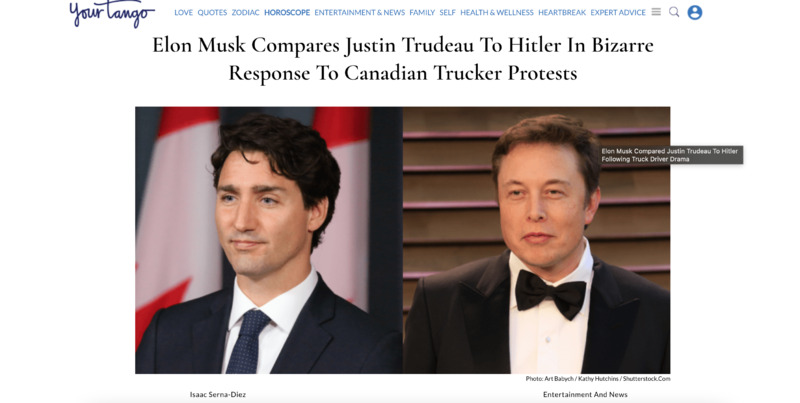 2022-02-17
2022-02-17Elon Musk Compares Justin Trudeau To Hitler In Bizarre Response To Canadian Trucker Protests
This is a news story from Your Tango by Isaac Serna-Diez. This is about a Twitter rant, where Elon Musk, owner of Tesla, compares Prime Minister Justin Trudeau to Adolf Hitler over the Canadian Trucker Protests. In January, both the United States and Canada imposed vaccine mandates. According to the American Trucking Association, only 50-60% of all truckers are vaccinated. The truckers have created a convoy that blocks traffic across the US-Canada border in response to the mandates. Trudeau's response to this was to invoke the Emergencies Act, which has't been used since 1988. The Emergencies Act allows for freezing of bank accounts and funds in order to take money away from those protesting. These freezes would also impact things like GoFundMe and the ability to raise funds from that site. It also allows for military involvement, but Trudeau says that he has no plans of doing so. Musk's response to what Trudeau imposed economically on protesters prompted him to promote cryptocurrency more. -
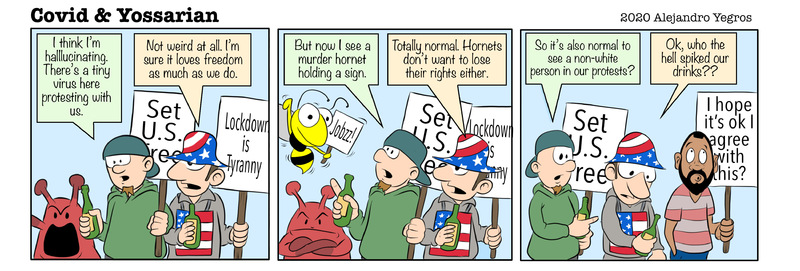 2020-05-08
2020-05-08Something funny about the protest
A comic strip about Covid-19 -
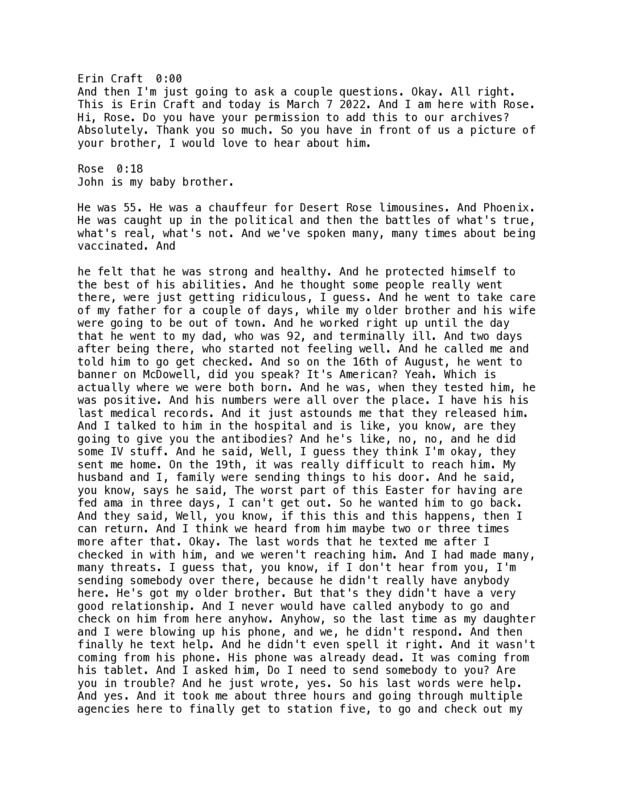 2022-03-07
2022-03-07Rose Oral History, 2022/03/08
At the Arizona Historical Society's 2nd annual Covid Memorial event, I spoke with Rose and recorded her story about losing her brother, John, to Covid. Rose describes the challenges she faced being far away from her brother as he was diagnosed and then ill. She currently has her brother's dog, Emma, and is trying to re-home her according to her brother's wishes. Rose describes how her last communication with her brother was a text for help. After the recording was turned off and we were walking out, she described how she felt when she was parked and walking to the hospital to say goodbye to her brother she saw anti-mask protestors at Central and Thomas Road. She was so sad and angry that these people were arguing against something that might save lives. She said that she couldn't argue with them and just wished them good health and walked away. -
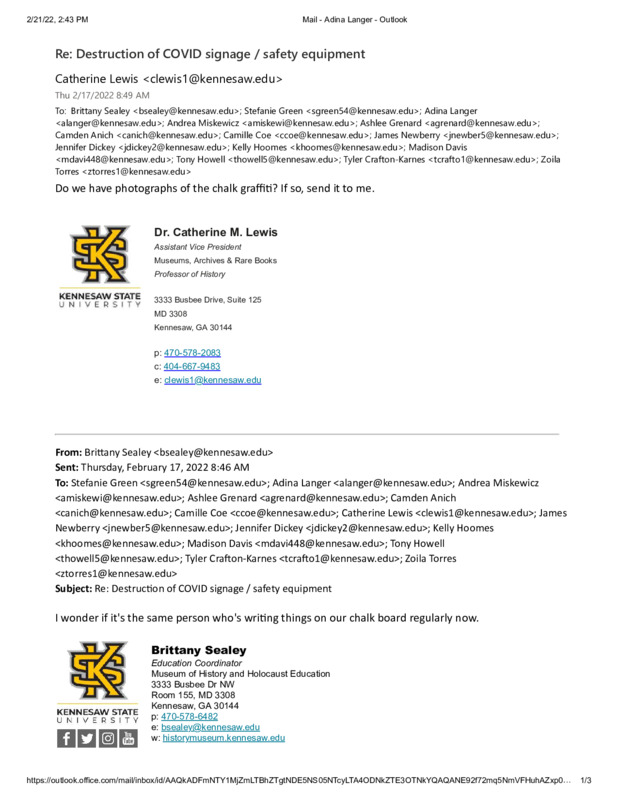 2022-02-16
2022-02-16Destruction of COVID signage/safety equipment
This email chain documents a series of incidents in my workplace where an anonymous individual has engaged in acts of vandalism against COVID safety signage. -
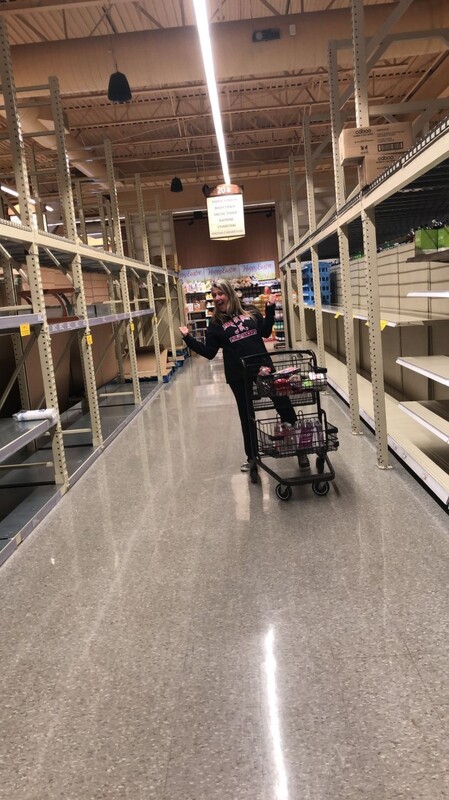 2022-02-05
2022-02-05The Bittersweet Impact of the Pandemic
March 13, 2020 was my last day as a student at Fairport High School in Rochester, NY, although I didn’t know it yet. I remember that day at school being filled with joking remarks, especially “Happy last day of school!” We discussed whether or not we thought school would close in economics class, and if it did, we came to the conclusion that it would only be a couple of weeks. The next day, I was in the car with my mom when I heard that school was to be closed indefinitely and that my dance studio, which I had been dancing at since I was three, also canceled classes. I started crying and got mad at myself that I took all those moments in the halls and with my teachers and friends for granted, as well as dance competitions and practice. But, I calmed myself down by reassuring myself that it would only be a couple weeks. My mom and I then went to Wegmans to see how empty the aisles were, and I was surprised to find that the cheese aisle was basically empty, and that there was no more toilet paper nor paper towels available. It’s weird looking back on how we weren’t wearing masks yet. The two weeks turned into months and on May 1st, school and dance stated that they were closed for the remainder of the year. I missed out on ball, my last dance competitions, my last dance recital, senior bash, and my graduation. We graduated by watching a poorly put-together slideshow of everyone’s pictures and pre-recorded speeches. Teachers came by and handed us our diplomas. We all drove by the dance studio the day that recital was supposed to be. However, despite these setbacks, I was able to learn more about myself and become closer to my family. My life that was previously extremely busy was put on pause, and sometimes I miss that. I started to paint, I watched a ton of movies that I had always wanted to see, I had time to spend with my dogs and cat, I got closer with my siblings, and I started to become an activist after the death of George Floyd and educate myself on racial inequalities and police brutality. The scariest part of quarantine was when my mother was redeployed to the COVID unit at RGH. She was only there for a couple weeks, but she saw how hectic and scary COVID truly was. She saw people die and not be able to say goodbye to their loved ones. Whenever she returned from work, I would have the front door propped open and the shower running so she could just jump right in the shower, and then I would spray everything with Lysol. Although I became majorly depressed in September of 2020 and I still dwell on the moments that I have missed, the pandemic was able to put my priorities into perspective. The pandemic was able to teach me not to take things for granted, to pay attention to the world around me, to try to make a difference in the world, and to make more time for the things and people that I love. May all those who have passed from COVID rest in peace and my heart goes out to all those impacted. -
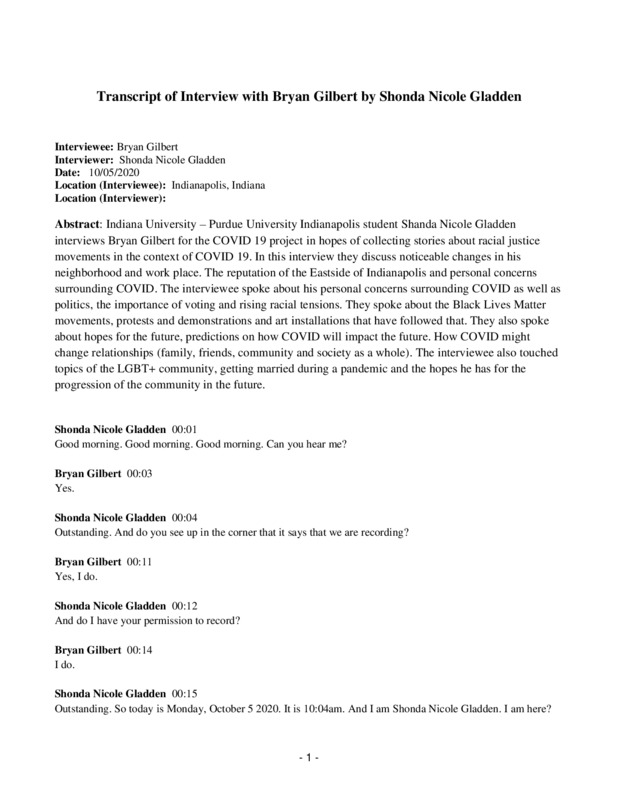 02/22/2021
02/22/2021Bryan Gilbert Oral HIstory, 2020/10/05
HIndiana University – Purdue University Indianapolis student Shanda Nicole Gladden interviews Bryan Gilbert for the COVID 19 project in hopes of collecting stories about racial justice movements in the context of COVID 19. In this interview they discuss noticeable changes in his neighborhood and work place. The reputation of the Eastside of Indianapolis and personal concerns surrounding COVID. The interviewee spoke about his personal concerns surrounding COVID as well as politics, the importance of voting and rising racial tensions. They spoke about the Black Lives Matter movements, protests and demonstrations and art installations that have followed that. They also spoke about hopes for the future, predictions on how COVID will impact the future. How COVID might change relationships (family, friends, community and society as a whole). The interviewee also touched topics of the LGBT+ community, getting married during a pandemic and the hopes he has for the progression of the community in the future. -
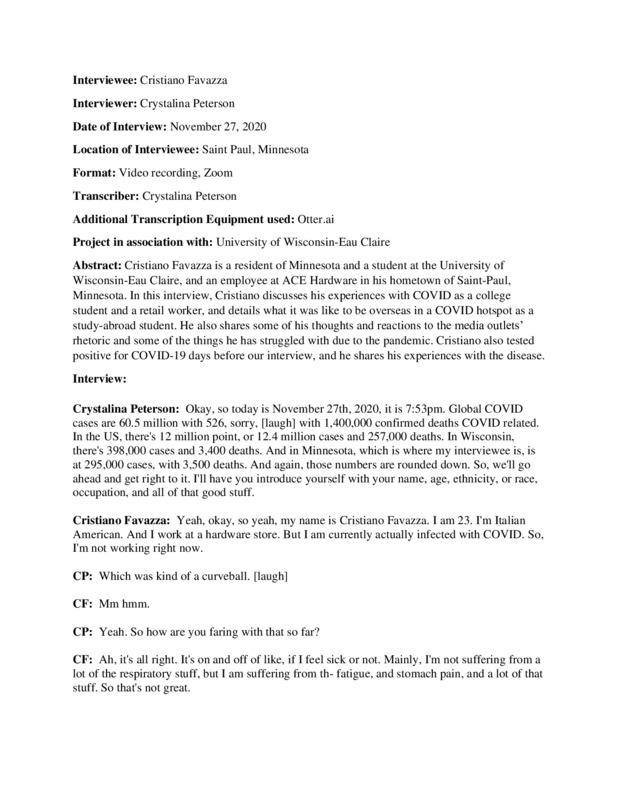 11/27/2020
11/27/2020Cristiano Favazza Oral History, 2020/11/27
C19OH -
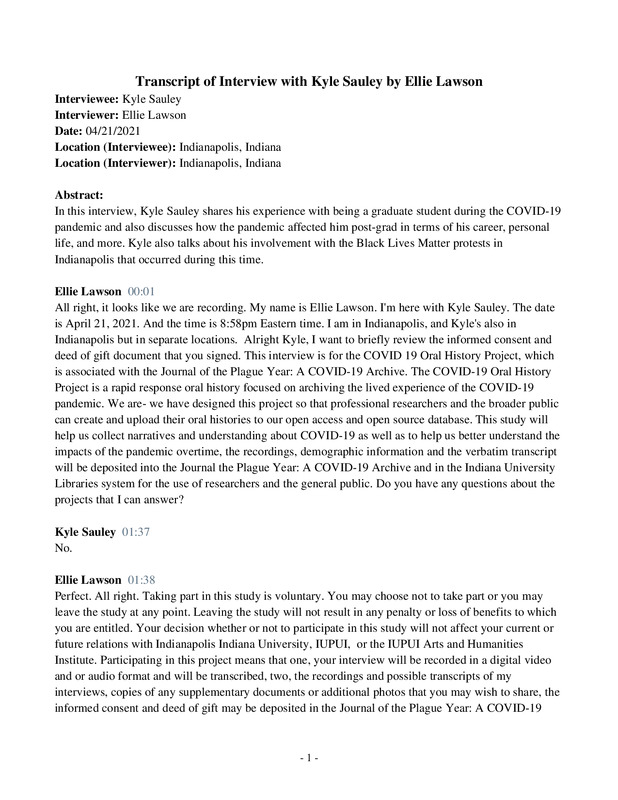 05/03/2021
05/03/2021Kyle Sauley Oral History, 2021/05/03
-
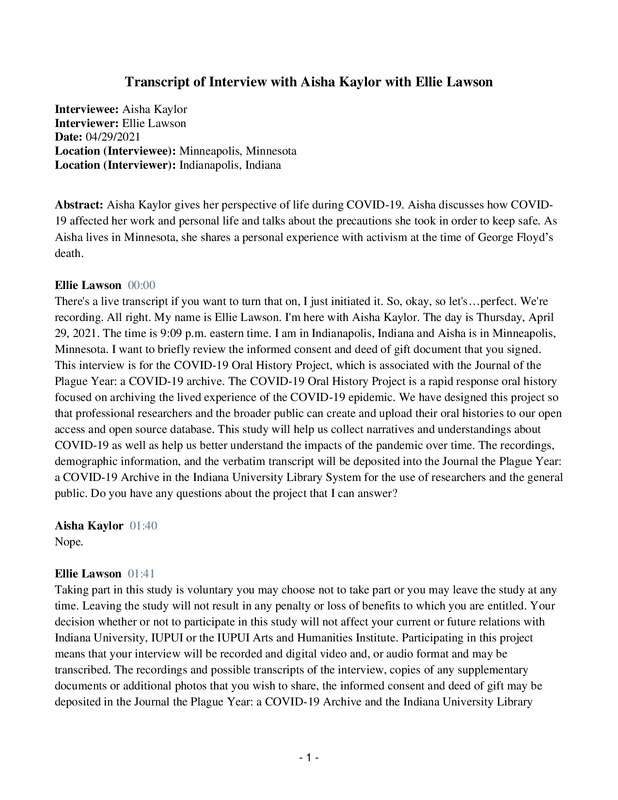 04/29/2021
04/29/2021Aisha Kaylor Oral History, 2021/04/29
-
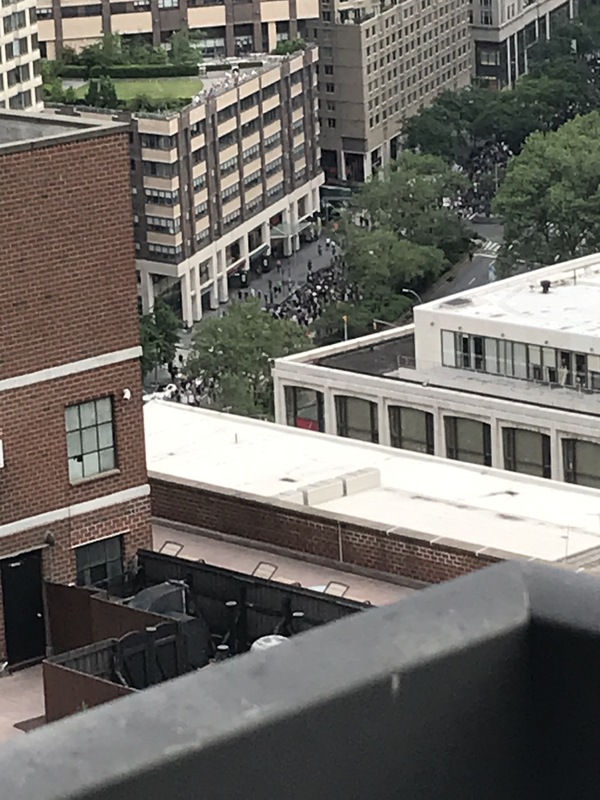 2020-06-03
2020-06-03Protests During COVID
A few months into the quarantining period, protests for the Black Lives Matter movement began all across America in response to the recent unjust violence against African Americans. From my apartment balcony I was able to see the protests in action as they went through my neighborhood, capturing a moment that I thought would be relevant in history for years to come. -
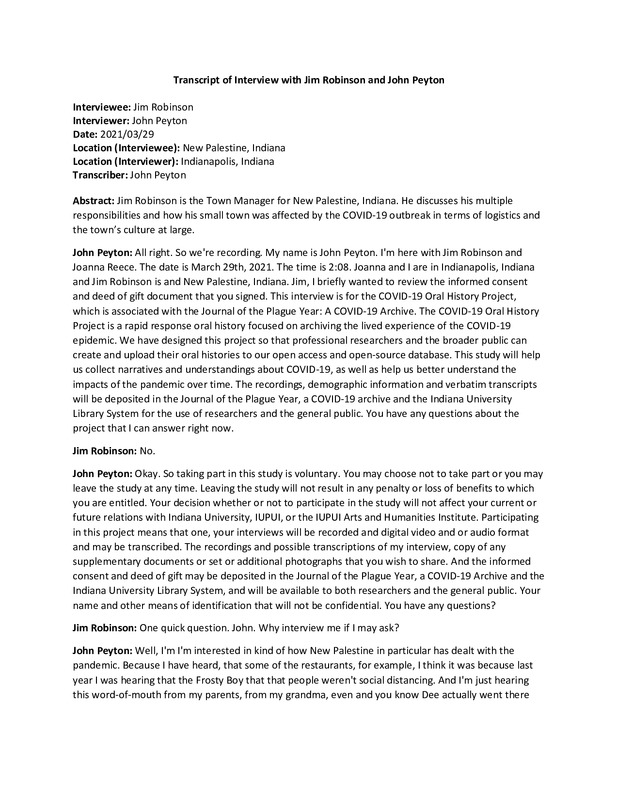 03/29/2021
03/29/2021Jim Robinson Oral History, 2021/03/29
-
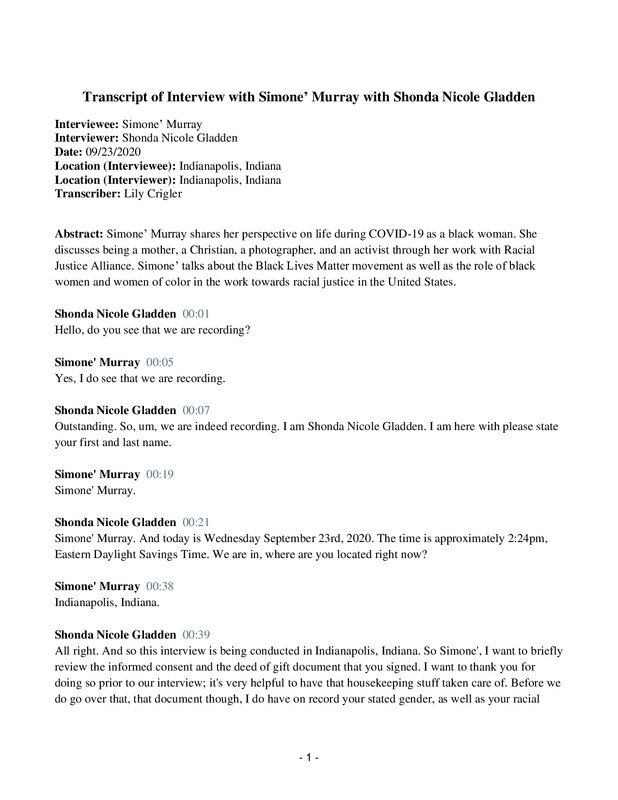 09/23/2020
09/23/2020Simone' Murray Oral History, 2020/09/23
-
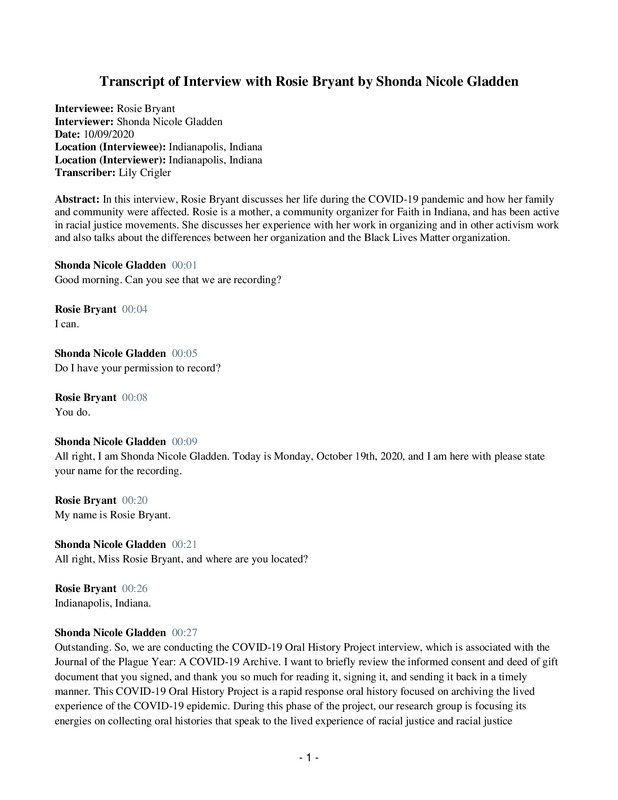 10/19/2020
10/19/2020Rosie Bryant Oral History, 2020/10/19
-
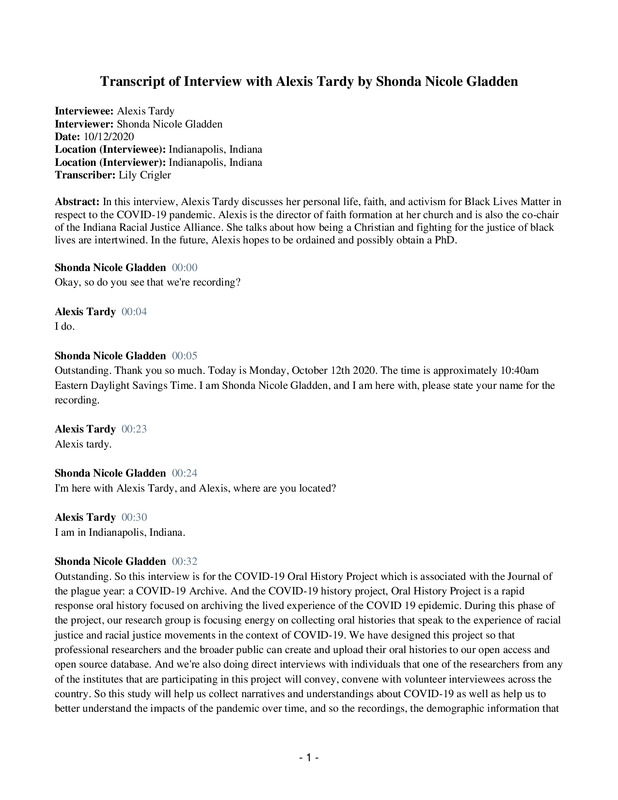 10/12/2020
10/12/2020Alexis Tardy Oral History, 2020/10/12
-
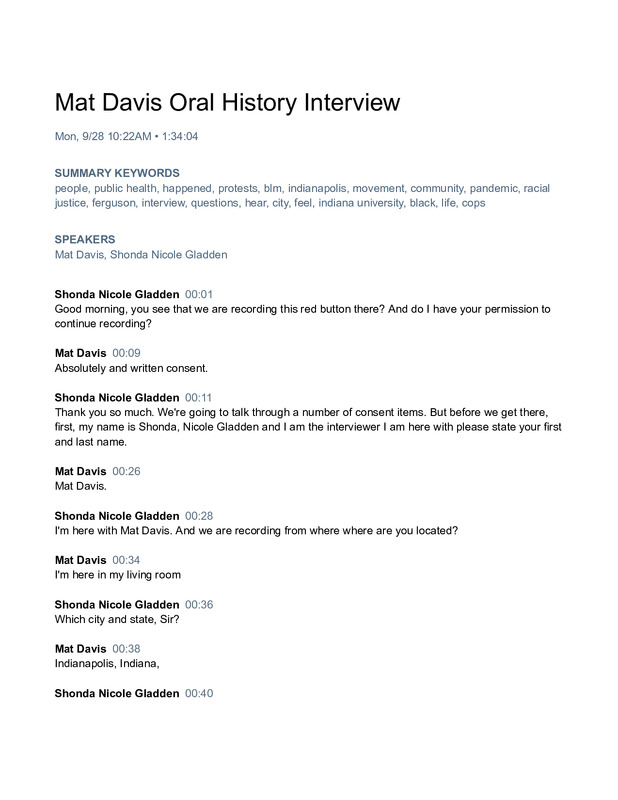 09/25/2020
09/25/2020Mat Davis Oral History, 2020/09/25
C19OH -
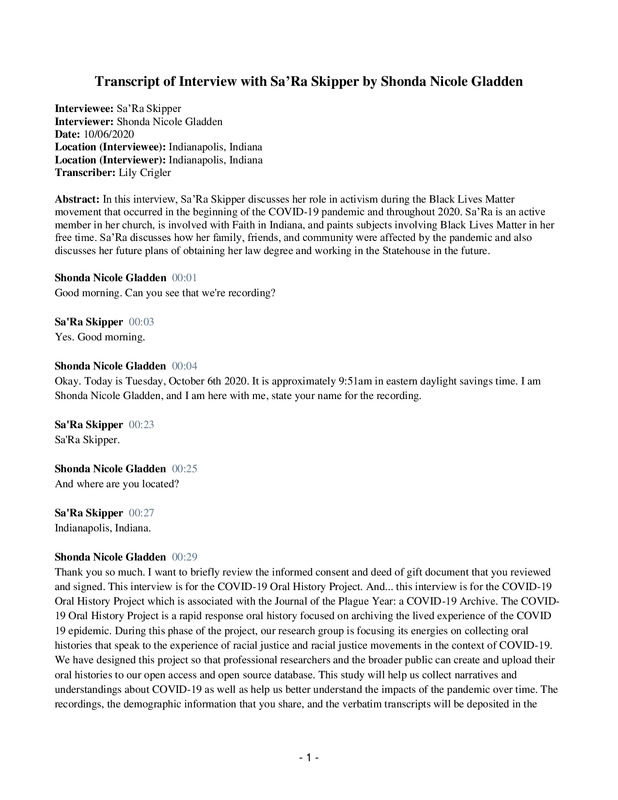 10/06/2020
10/06/2020Sa'Ra Skipper Oral History, 2020/10/06
-
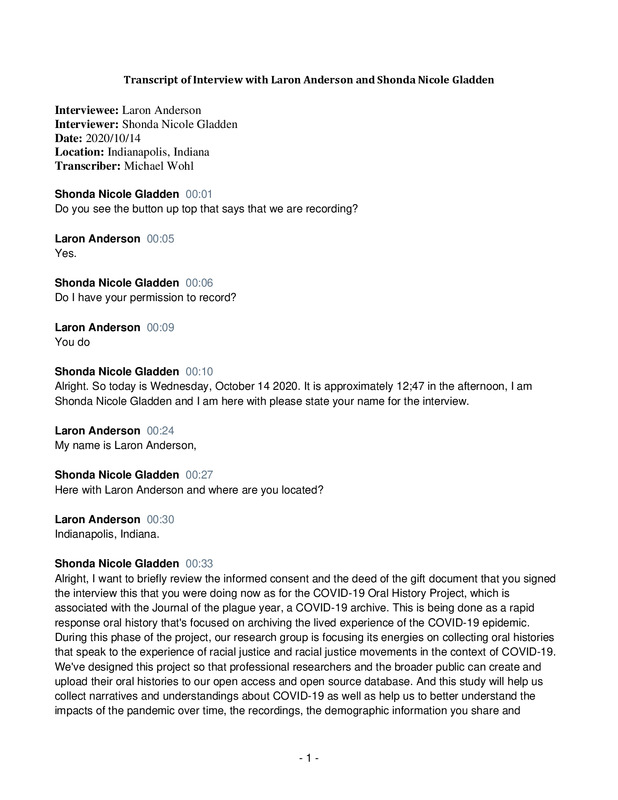 10/14/2020
10/14/2020Laron Anderson Oral History, 2020/10/14
-
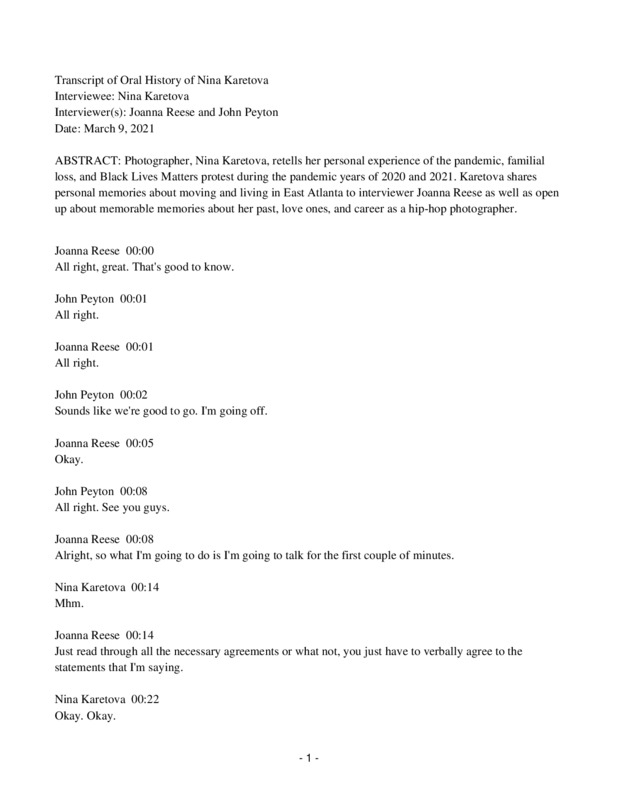 05/02/2021
05/02/2021Nina Karetova Oral History, 2021/03/09
Indiana University advocate, Joanna Reese interviews Atlanta photographer, Nina Karetova. -
2020-06-19
What Do You Do When the World Is Ending?
If you were around on May 30, 2020, you would know that it really did feel like the world was ending. Cities across the country were ablaze with rebellious fire, police and military covered the streets, bridges were lifted. All this during a global pandemic. To be there to be a part of it all, it felt like the world was ending. So, what do you do when the world is ending? There are many answers to this question and while I chose to answer it in multiple ways, one of the primary answers was this: documentation. I documented what felt like the end of the world. Through words, videos, photographs, tweets. Any way I could. But through documenting the end of the world, I encountered some of the most beautiful moments. Moments of peace, of beauty, of love, of collective and mutual care. One of those moments is pictured here. -
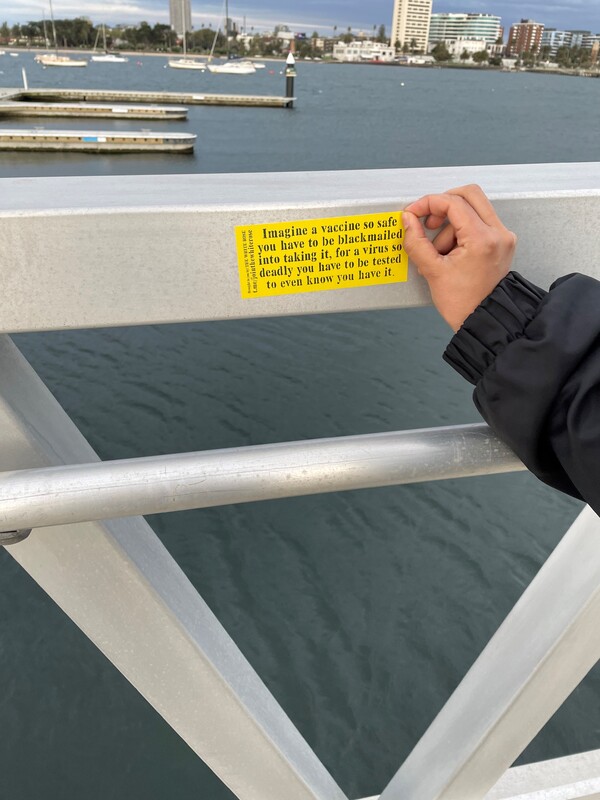 2021-09-19
2021-09-19HIST30060 Misinformation
This image I took down the St. Kilda pier. Someone had left various stickers that spread misinformation about covid, lockdowns and the vaccine. My friends and I decided it was best to remove these stickers as they are quite harmful. Living in Melbourne it has been so tiring watching ‘freedom protestors’ and people from far-right groups constantly spread misinformation and attend protests during stage 4 lockdowns (where we can only leave the house for the essentials). The fear-mongering these groups do its quite upsetting as I’ve seen my friends and some distant family members share their information on social media. The ‘anti-vaxxers’ and covid deniers even compare wearing a mask, getting vaccinated and being in lockdown to the Holocaust, which is so harmful and upsetting -
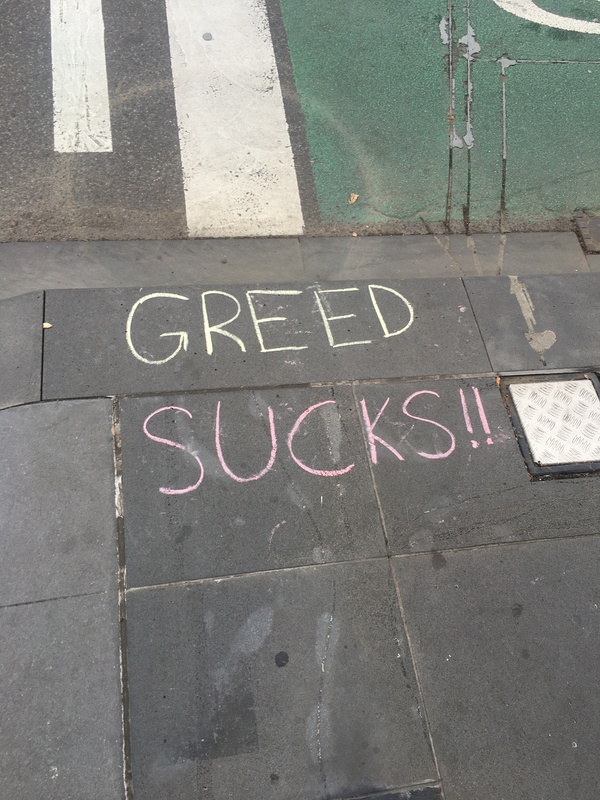 2021-09-08
2021-09-08HIST30060: GREED SUCKS
I found this chalk slogan on the road hilariously neo-liberal. Absolutely, greed sucks - the way COVID-19 exacerbated wealth inequalities and ravaged communities disproportionately (due to lack of resources/access and over-policing) sucks. Yet, this chalked slogan was a simplification (or even armchair activist representation) of that reality and this made me chuckle. -
 2021-09-21
2021-09-21HIST30060 Footage of smoke on the Westgate Bridge during anti-lockdown protests in Melbourne
This video was taken on 21 September 2021, capturing the view of the Westgate Bridge from Williamstown, Melbourne, as anti-lockdown protestors fill several lanes and disrupt traffic. The footage shows smoke coming from the bridge and all traffic brought to a standstill. There were also helicopters hovering and police car lights joining the scene later on. I was on a walk with a friend along the Esplanade at the time this footage was taken. It felt quite scary to be seeing aggressive, violent attitudes manifest so close to home. We knew what was going because of news updates coming through our phones. After the initial shock and fear at witnessing this happening on a few kilometres away, my friend and I walked the rest of the way in silence, too appalled by the behaviour to do more than shake our heads in dismay. -
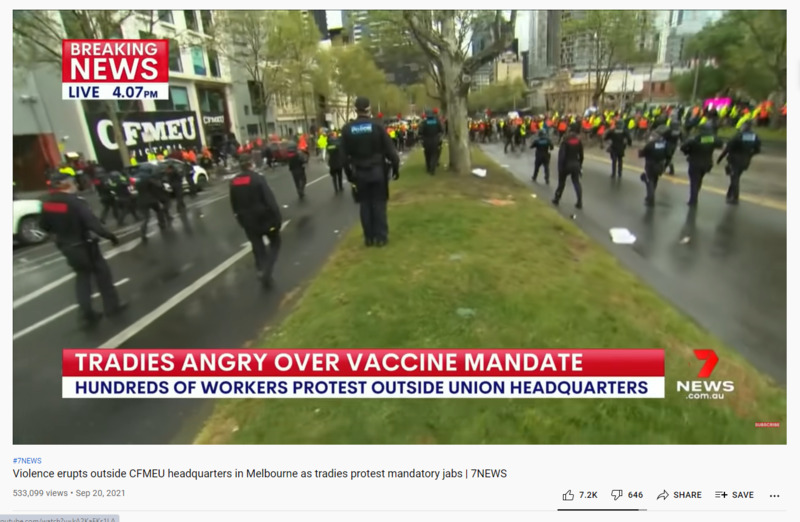 2021-09-21
2021-09-21(HIST30060) CFMEU Protests
HIST30060. Following a state-wide construction vaccine mandate on the 20st of September, 2021, the CFMEU headquarters was violently ransacked. 'Tradies' or construction workers believed the CFMEU had not stood up for their rights. Violent scenes erupted between CFMEU leaders inside the headquarters and union members who had turned up to protest the vaccine mandate. Many Victorians watched the events unfold on livestream via Facebook and YouTube. Commentators noted that these protests were hijacked by far-right agitators attempting to destabilize the state through protests, especially during a pandemic where large gatherings are considered dangerous and illegal. Ultimately, the Andrews Government responded to the event by shutting down the entire construction sector for two weeks. This functioned as catalyst that pushed thousands of construction workers to protest for many days in the CBD. Ugly clashes between protestors and Victoria Police removed any validity or standing they may have had. Most people in the community heavily criticised those present, especially when other sectors (e.g. retail, hospitality, entertainment) had not been able to work for over 18 months. -
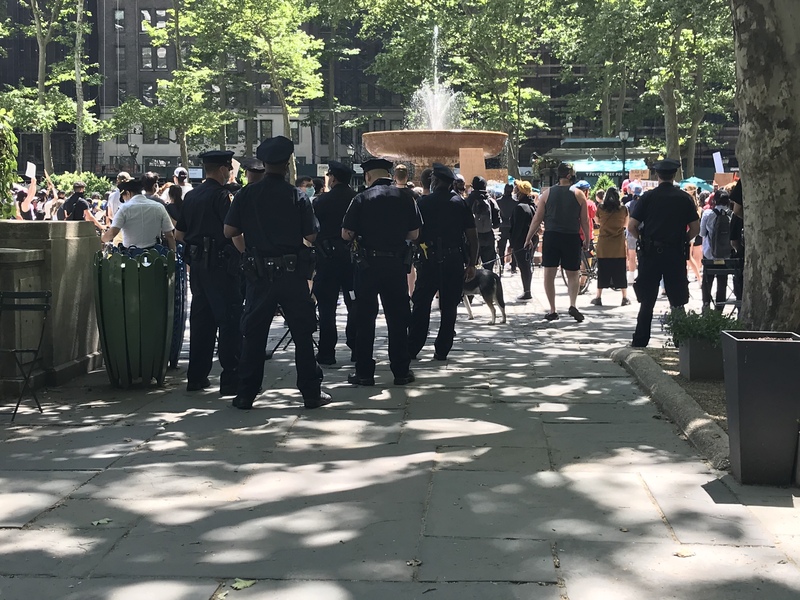 2020-05
2020-05Images from George Floyd Protests and BLM Demonstrations in New York City
Images taken of signs held while listening to speeches from BLM activists. Another image shows a cluster of police during a demonstration in Midtown Manhattan. -
 2020-05-31
2020-05-31I Can't Breathe
We marched up 4 miles of downtown Greenville chanting his name throughout the streets. I remember feeling like his name was a battle cry. I call to action. And a call for us to rise up and understand the true meaning of reason of why we choose to gather here today. George Floyd. His life was was tragically taken but his legacy was lovingly memorialize. It was beautiful to see and take part of historical moment like that. A moment of where a marginalized individual was taken out of the gaps and silences of history and placed right front and center within our cultural and society. -
 2020-06-03
2020-06-03Take the Pledge
I regrets speaker's name but remember the impact of her words at the Black Lives Matter protest held in Anderson, South Carolina. This speaker talked about the importance of peace and understanding when joining arms with brethren and allies during pivotal times. I remember her walking off the platform and wishing I could her more. Overall, her speech was fierce, firm, and empathetic to us and the cause. Her call to action by asking the audience to take a pledge embodies to true spirit and essence of Black Lives Matter protest. -
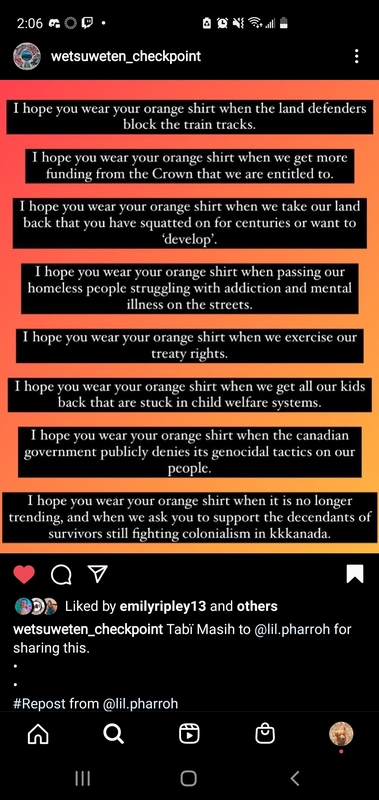 2021-09-30
2021-09-30I hope you wear your orange shirt
A post on Instagram about the need for continual support for Indigenous peoples when it comes to protecting their sovereignty; and in resisting colonialism. -
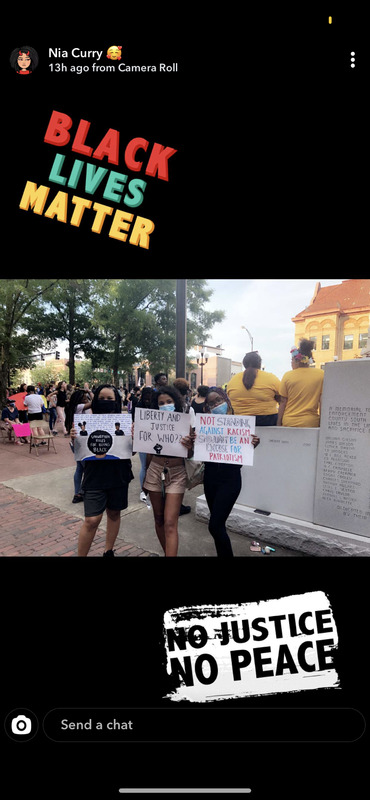 2020-06-04
2020-06-04Small Town, Big Affairs
The challenges of both COVID-19 and the lockdown illuminated the disproportionate burden black and brown communities have been facing with jobs, communities, and police. In the midst of the profound trauma of George Floyd's death, many communities had to come together to address what parameters were they enforcing for both the health and safety for its member. Many protest like the one shown in Anderson, South Carolina took place May-August of 2020 to demonstrate how a growing pandemic forced individuals to think about others' vulnerabilities--specifically those inflicted from police brutality. -
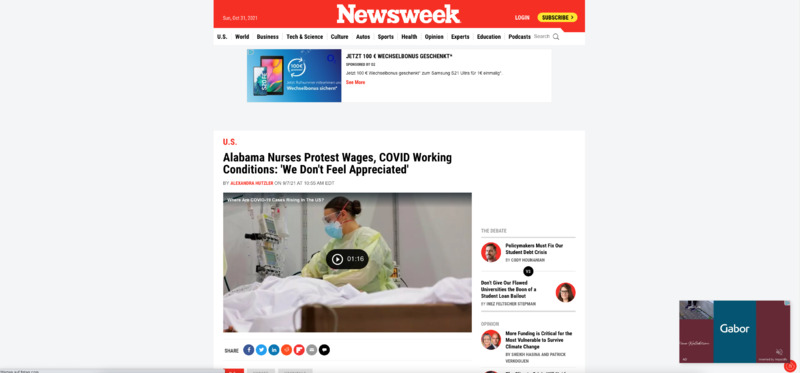 2021-09-07
2021-09-07Alabama Nurses Protest Wages, COVID Working Conditions: 'We Don't Feel Appreciated'
Nurses in Birmingham, Alabama protested unequal compensation and poor working conditions at UAB Hospital by refusing to clock-in for the night shift. -
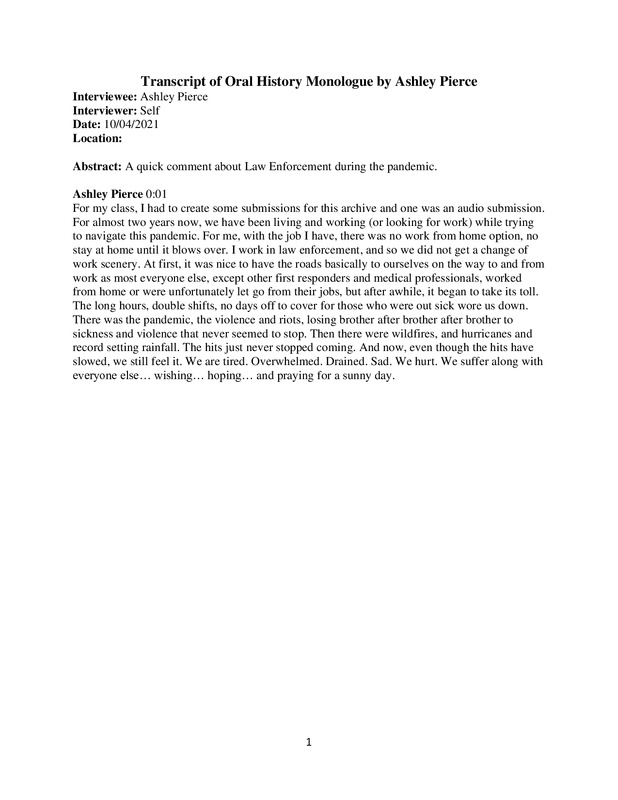 2021-10-04
2021-10-04Ashley Pierce Oral History, 2021/10/04
A quick comment about Law Enforcement during the pandemic. -
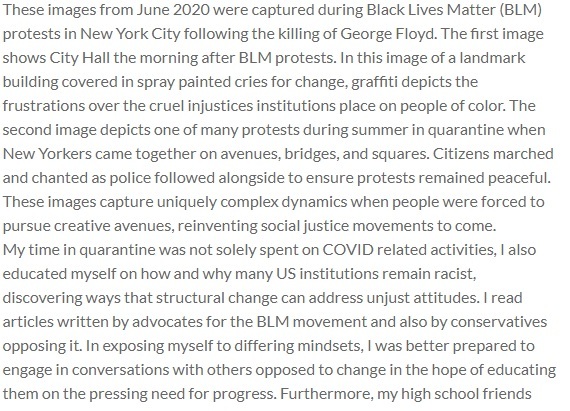 2020-06
2020-06Pandemic Protests
These images from June 2020 were captured during Black Lives Matter (BLM) protests in New York City following the killing of George Floyd. The first image shows City Hall the morning after BLM protests. In this image of a landmark building covered in spray painted cries for change, graffiti depicts the frustrations over the cruel injustices institutions place on people of color. The second image depicts one of many protests during summer in quarantine when New Yorkers came together on avenues, bridges, and squares. Citizens marched and chanted as police followed alongside to ensure protests remained peaceful. These images capture uniquely complex dynamics when people were forced to pursue creative avenues, reinventing social justice movements to come. My time in quarantine was not solely spent on COVID related activities, I also educated myself on how and why many US institutions remain racist, discovering ways that structural change can address unjust attitudes. I read articles written by advocates for the BLM movement and also by conservatives opposing it. In exposing myself to differing mindsets, I was better prepared to engage in conversations with others opposed to change in the hope of educating them on the pressing need for progress. Furthermore, my high school friends and I frequently Zoomed to discuss how our alma mater contributes to racism in both subtle and overt ways. These conversations allowed us to work with fellow alumni, as well as current students, to create a document clearly listing racial inequities within the student body, the faculty, and the curriculum. For each issue that we highlighted, we provided multiple alternatives for how the school could fix the matter in question. While these conversations were unexpected before the BLM protests occurred, they became productive and fulfilling conversations that in and of themselves began to address long held biases, racist representations and undercurrents of injustice within our alma mater’s community and programs.
